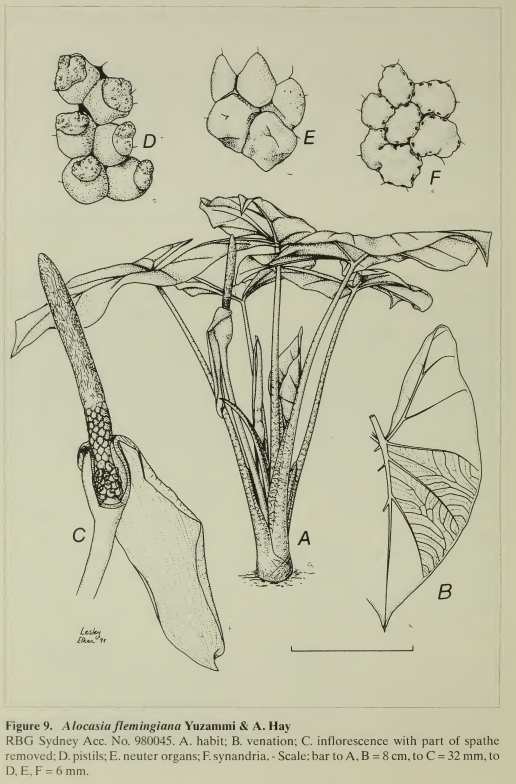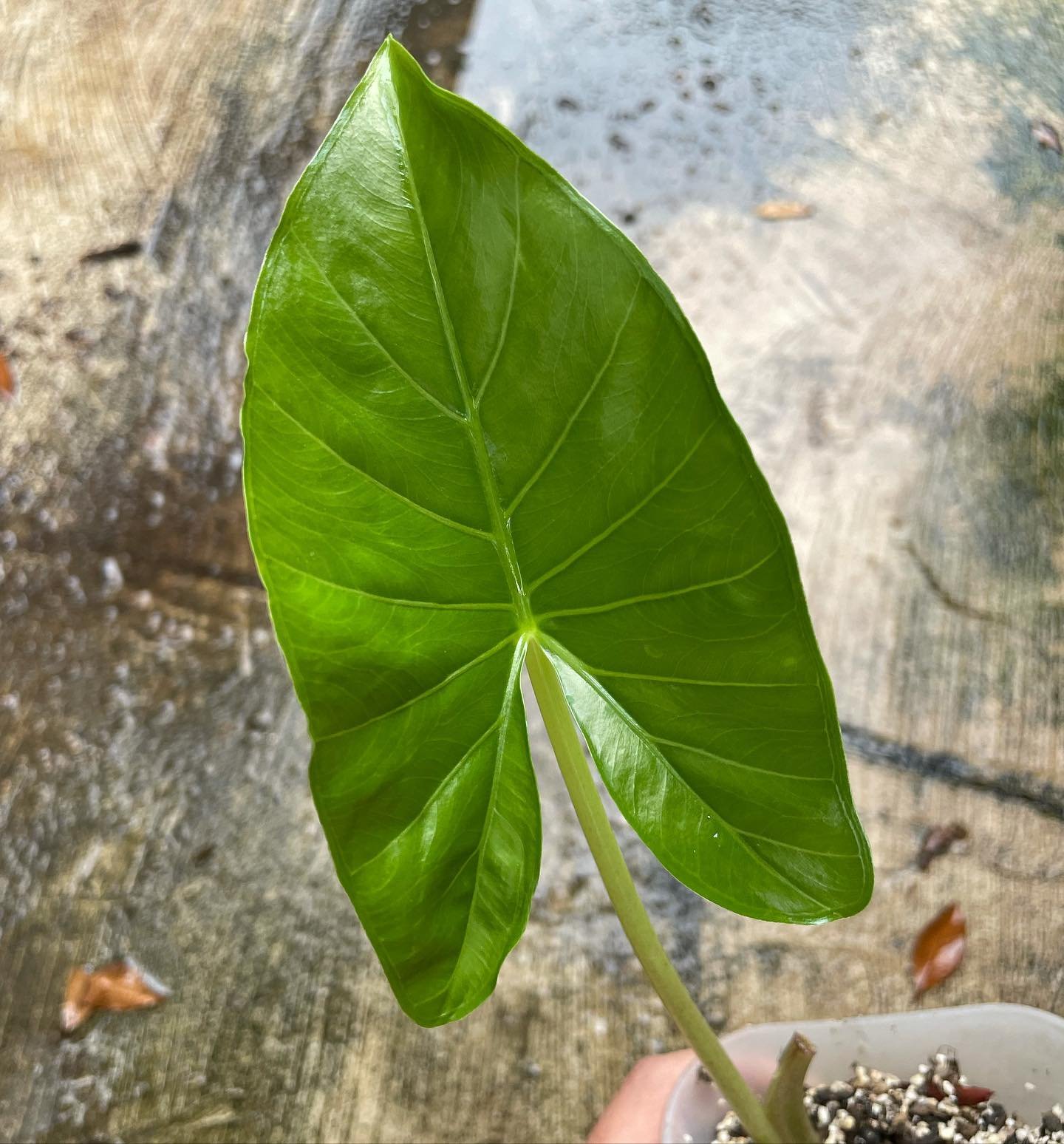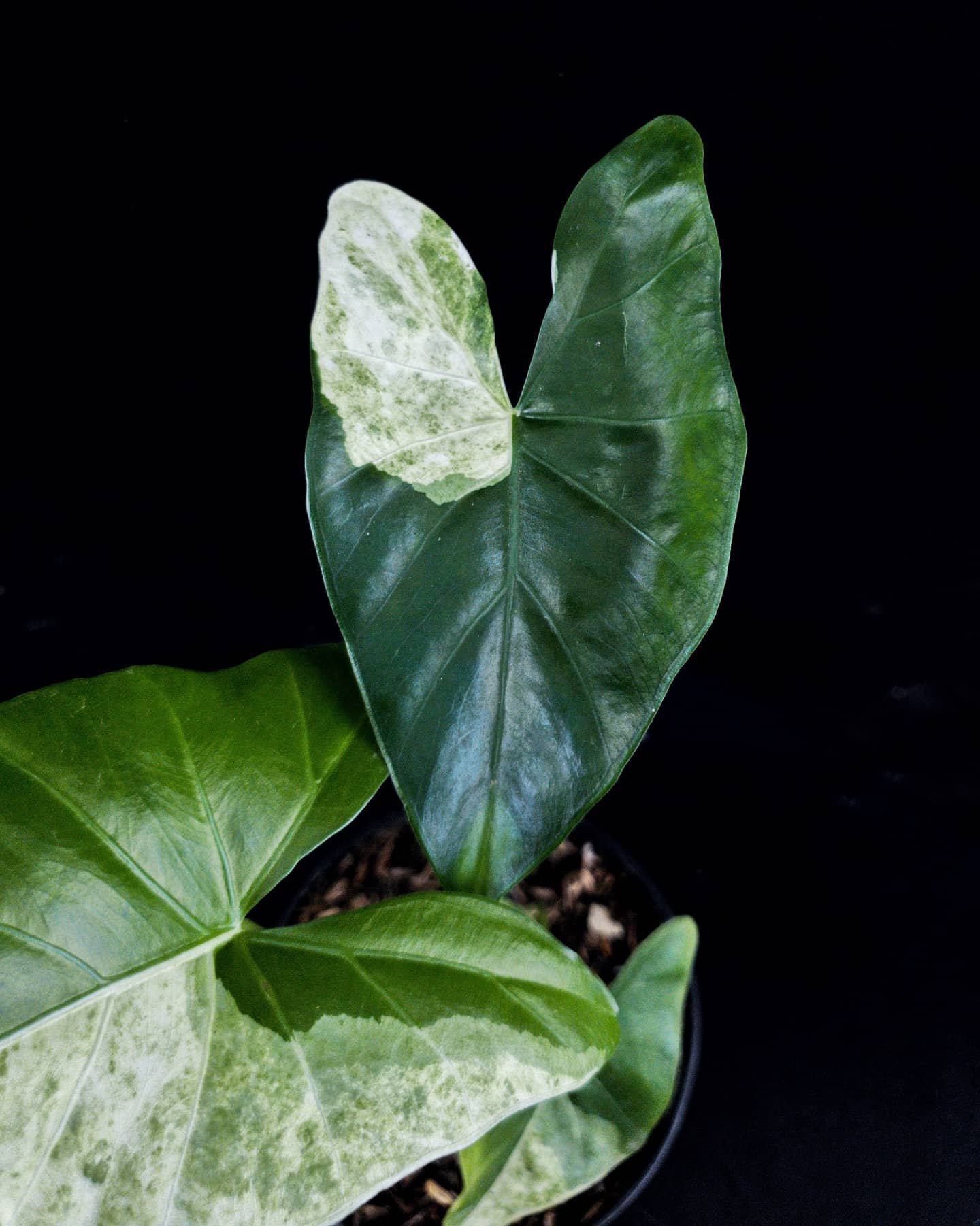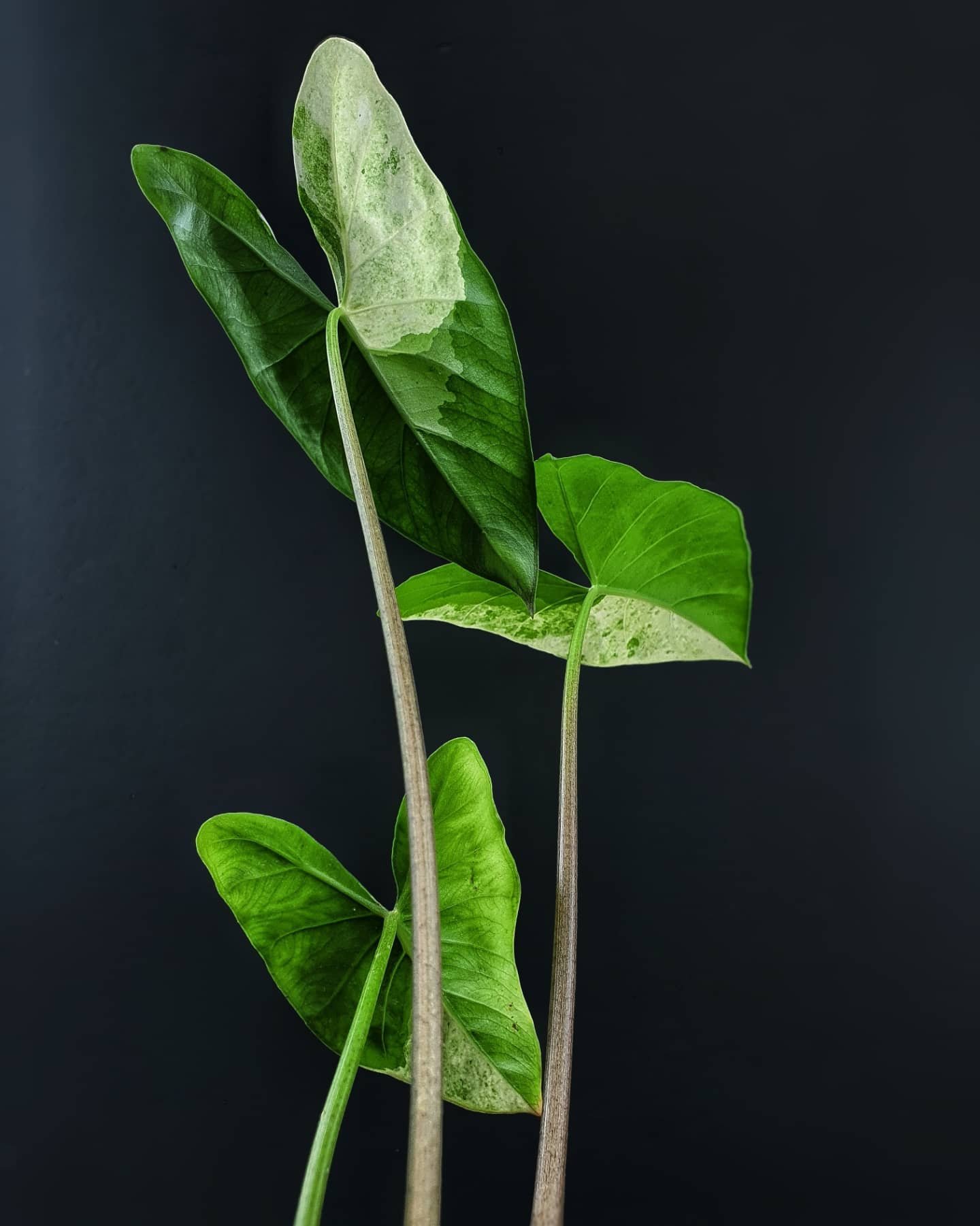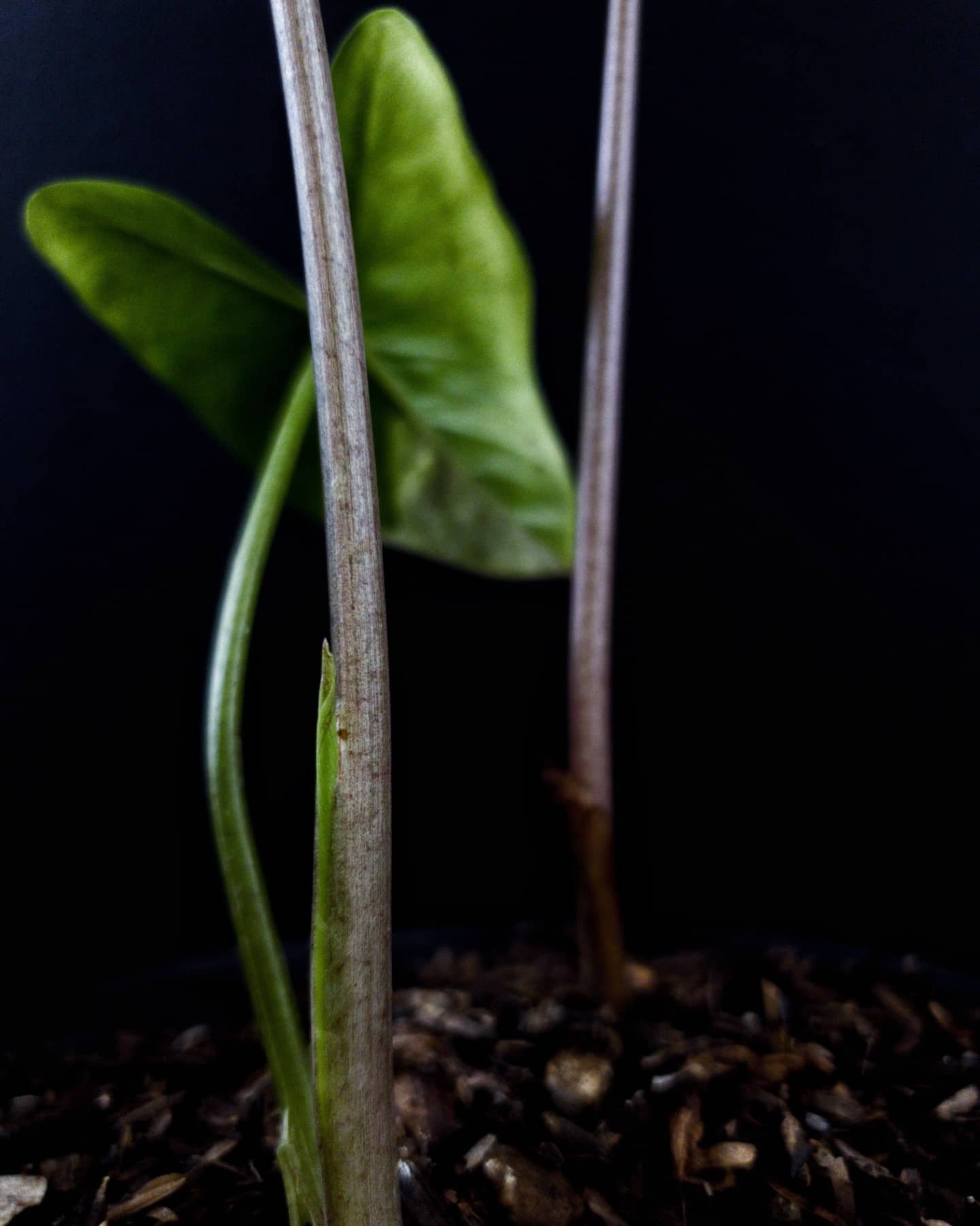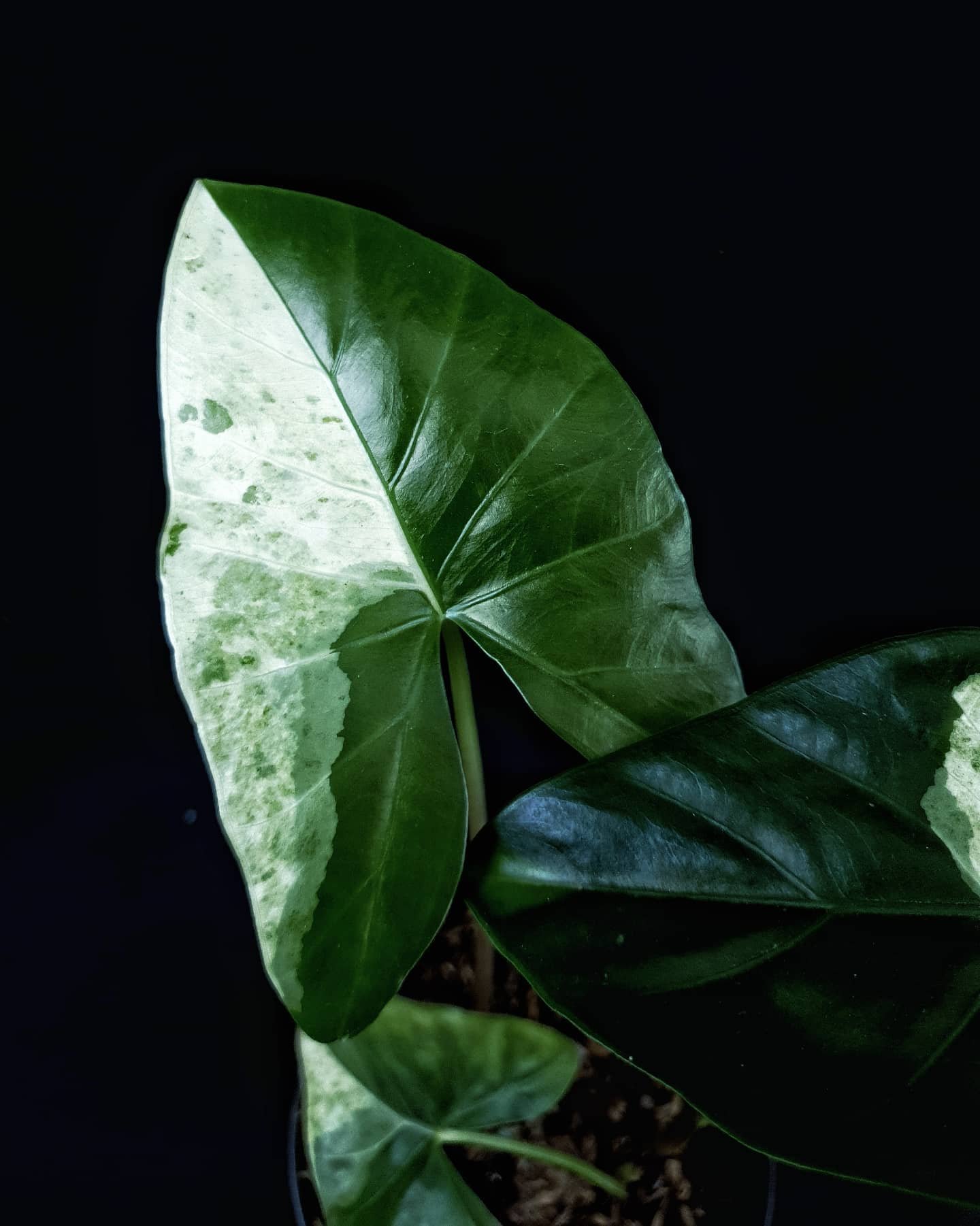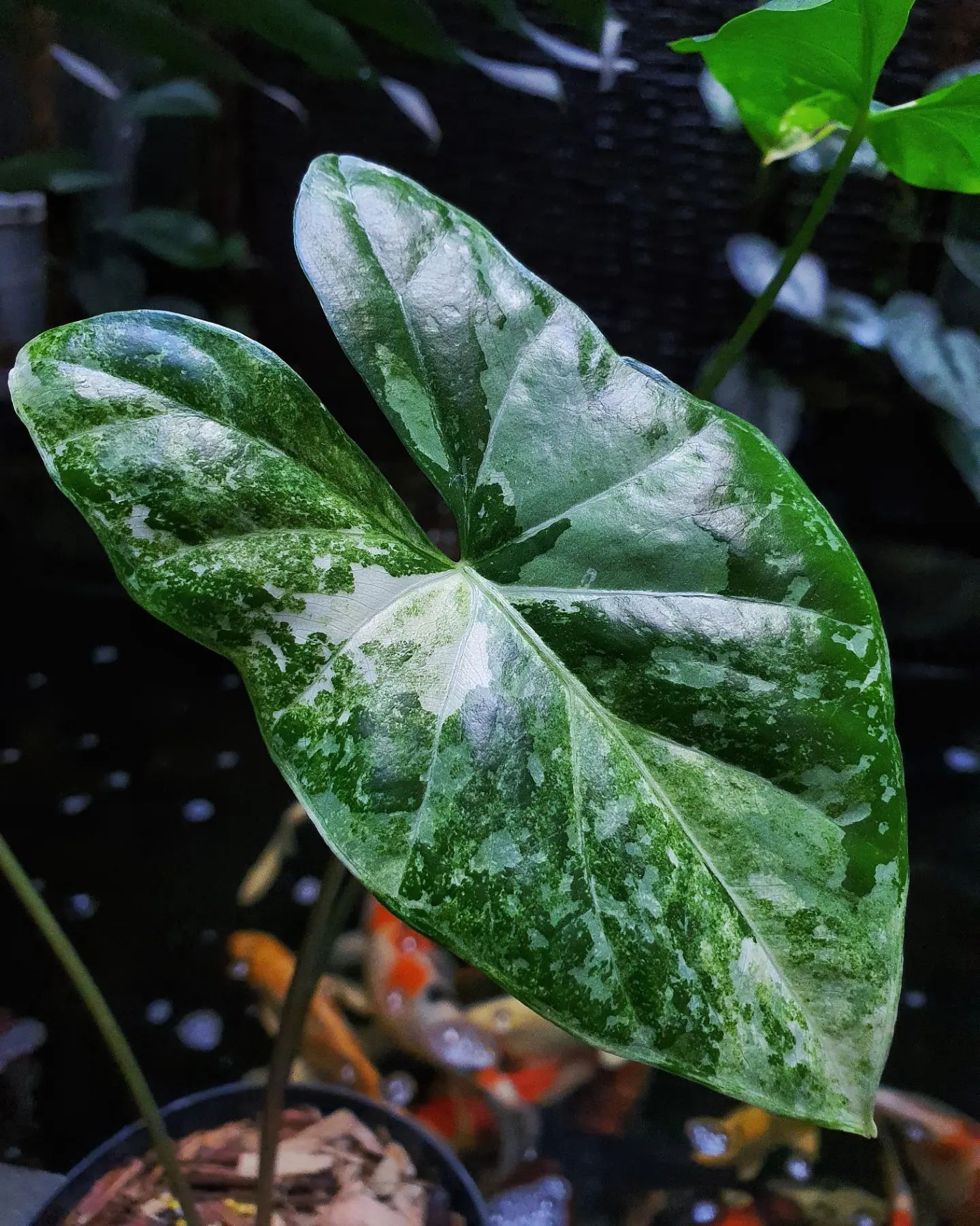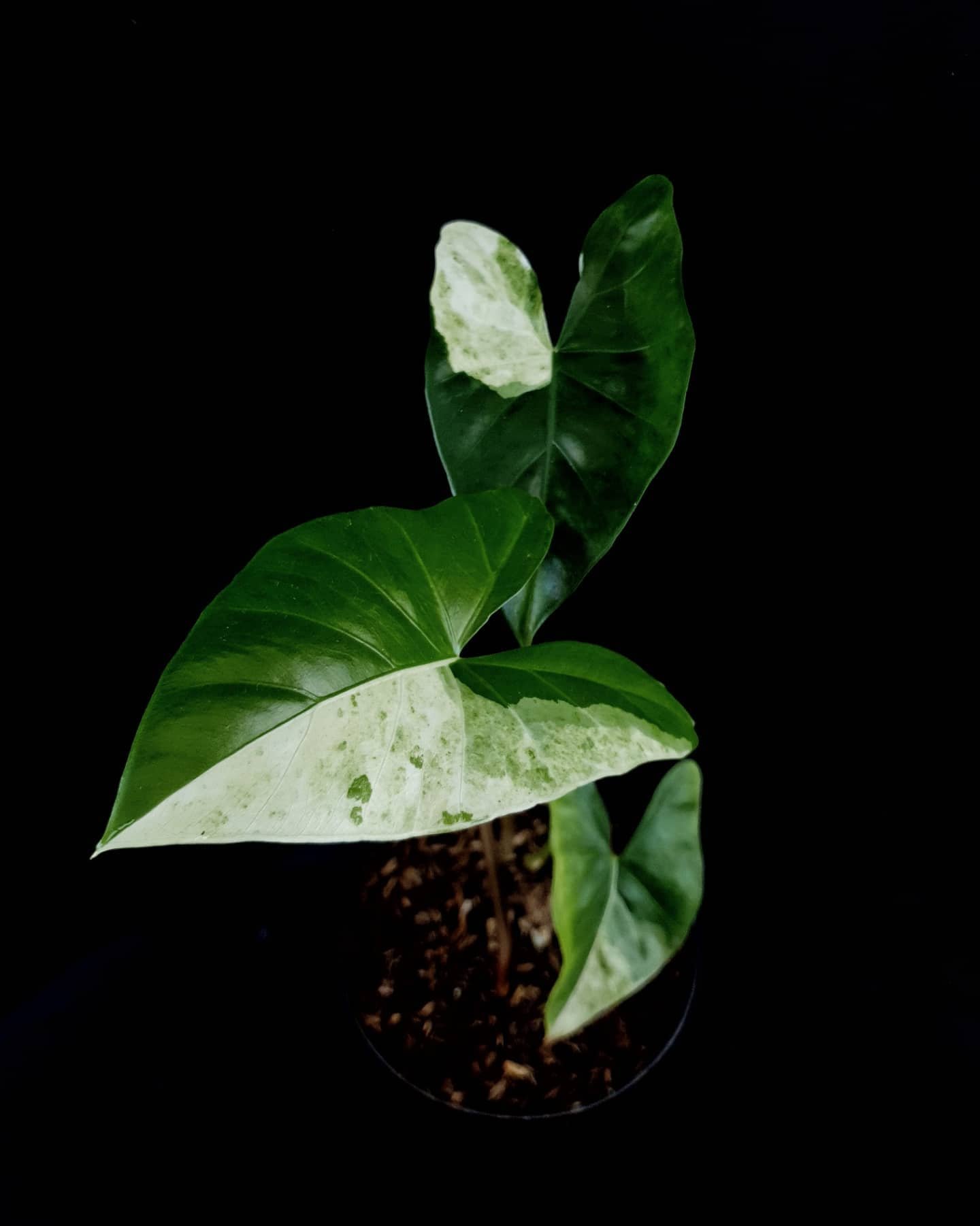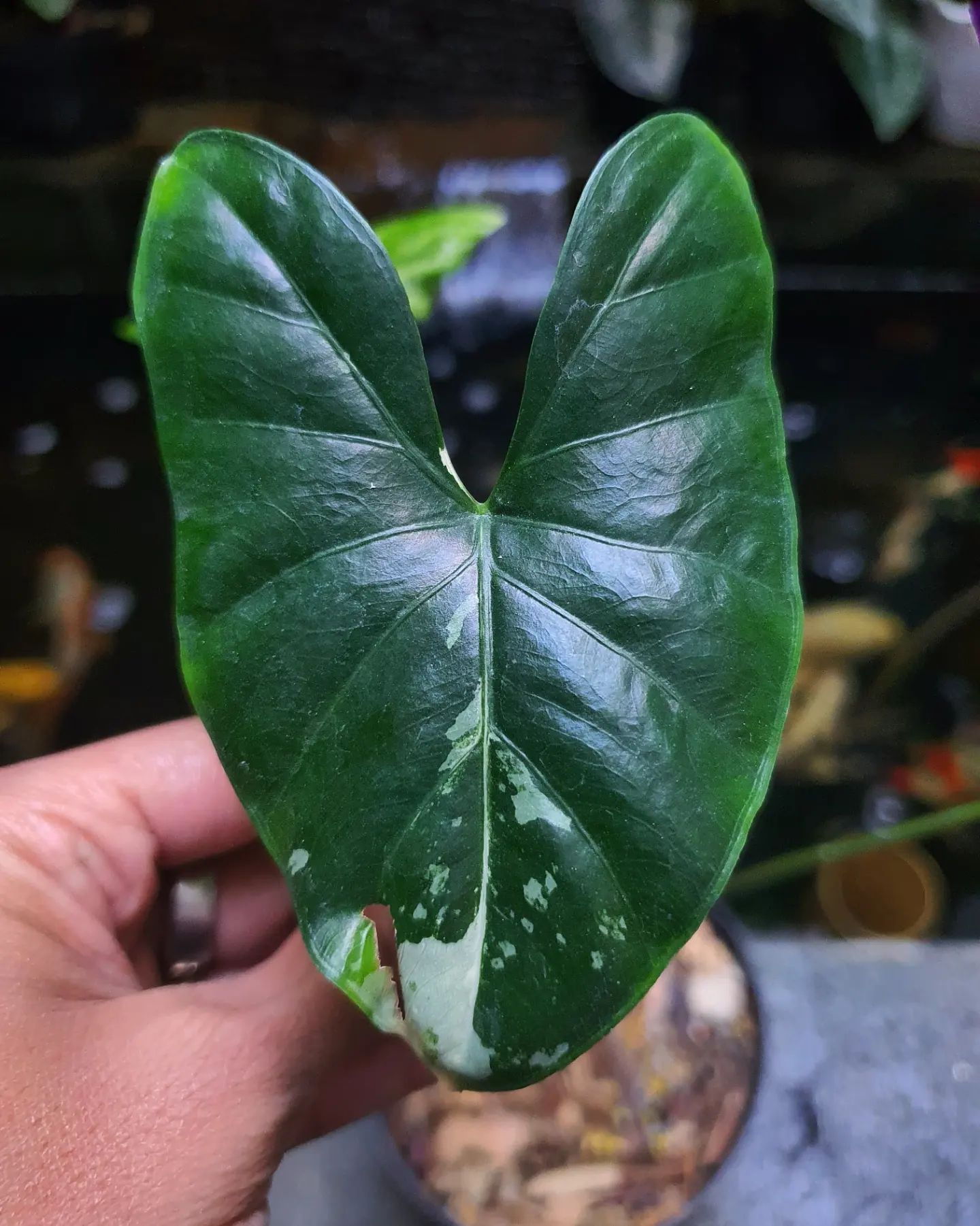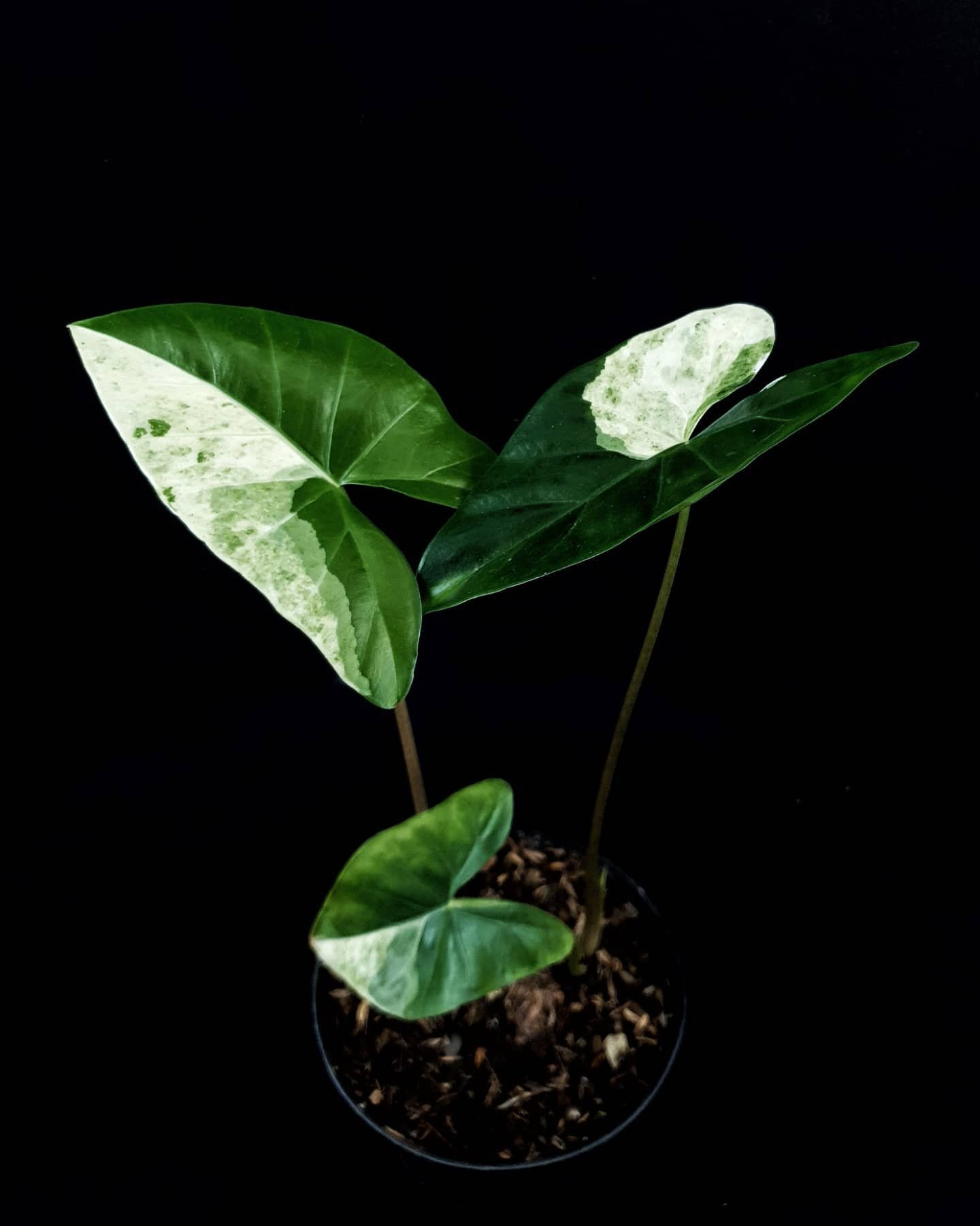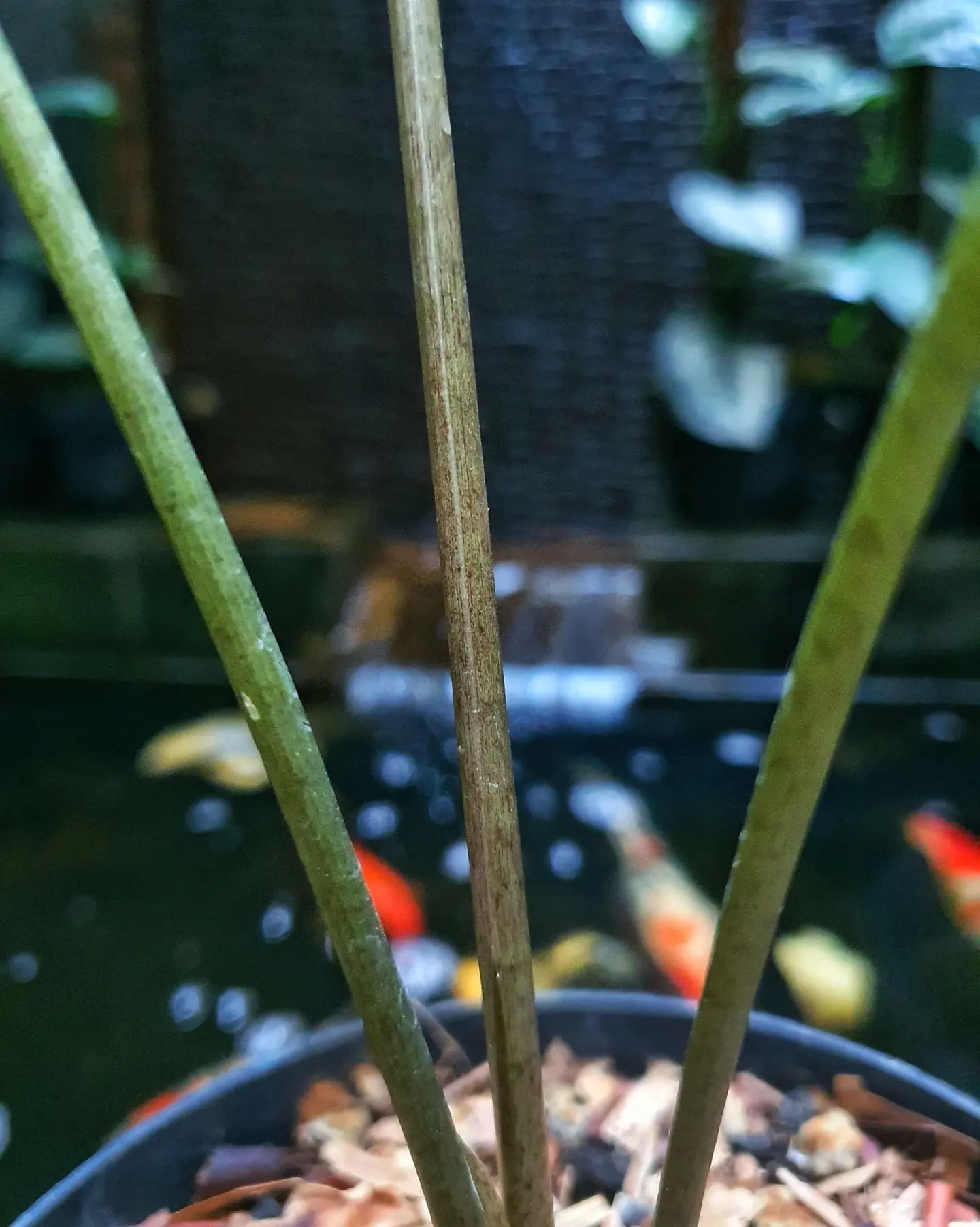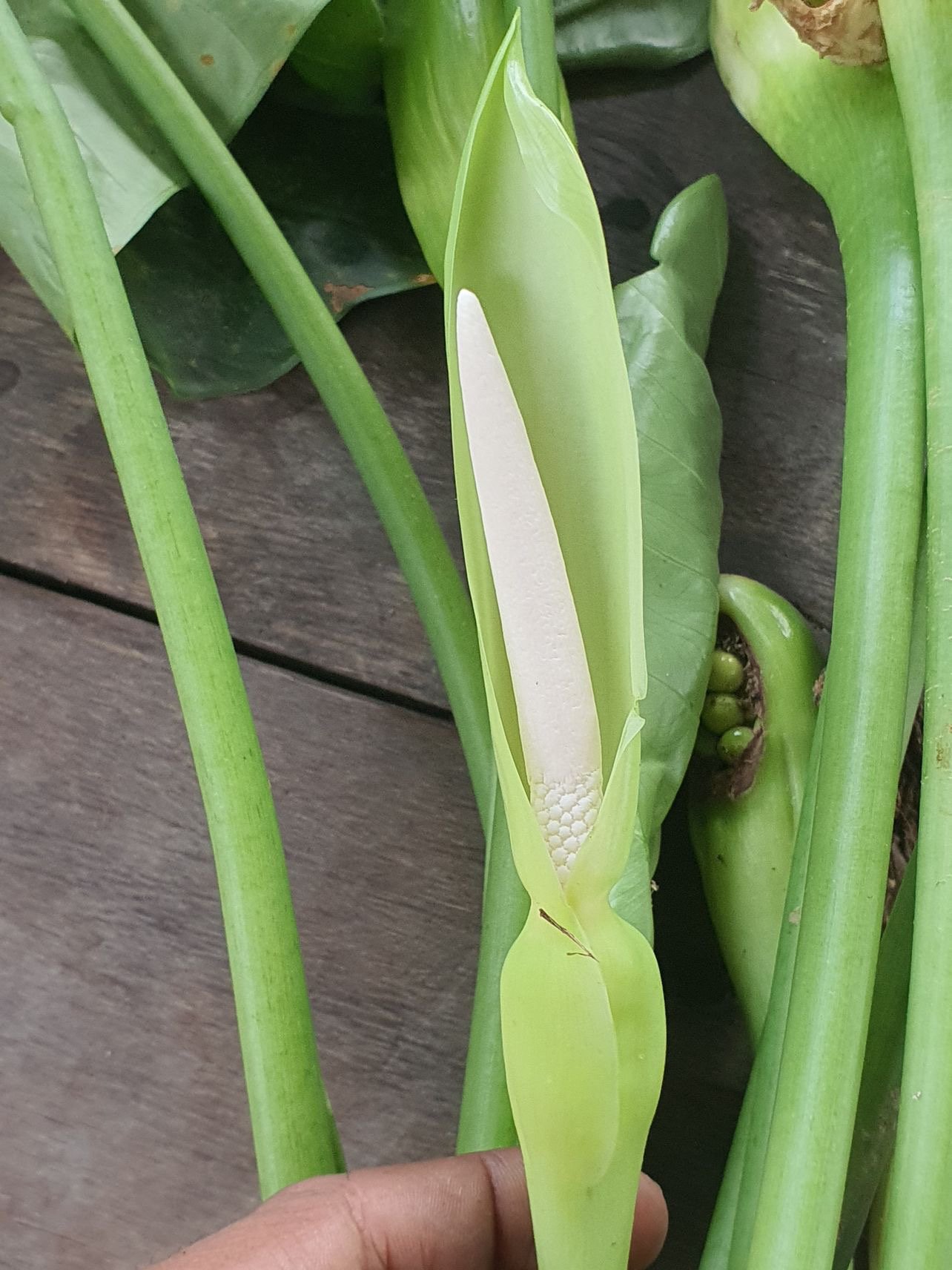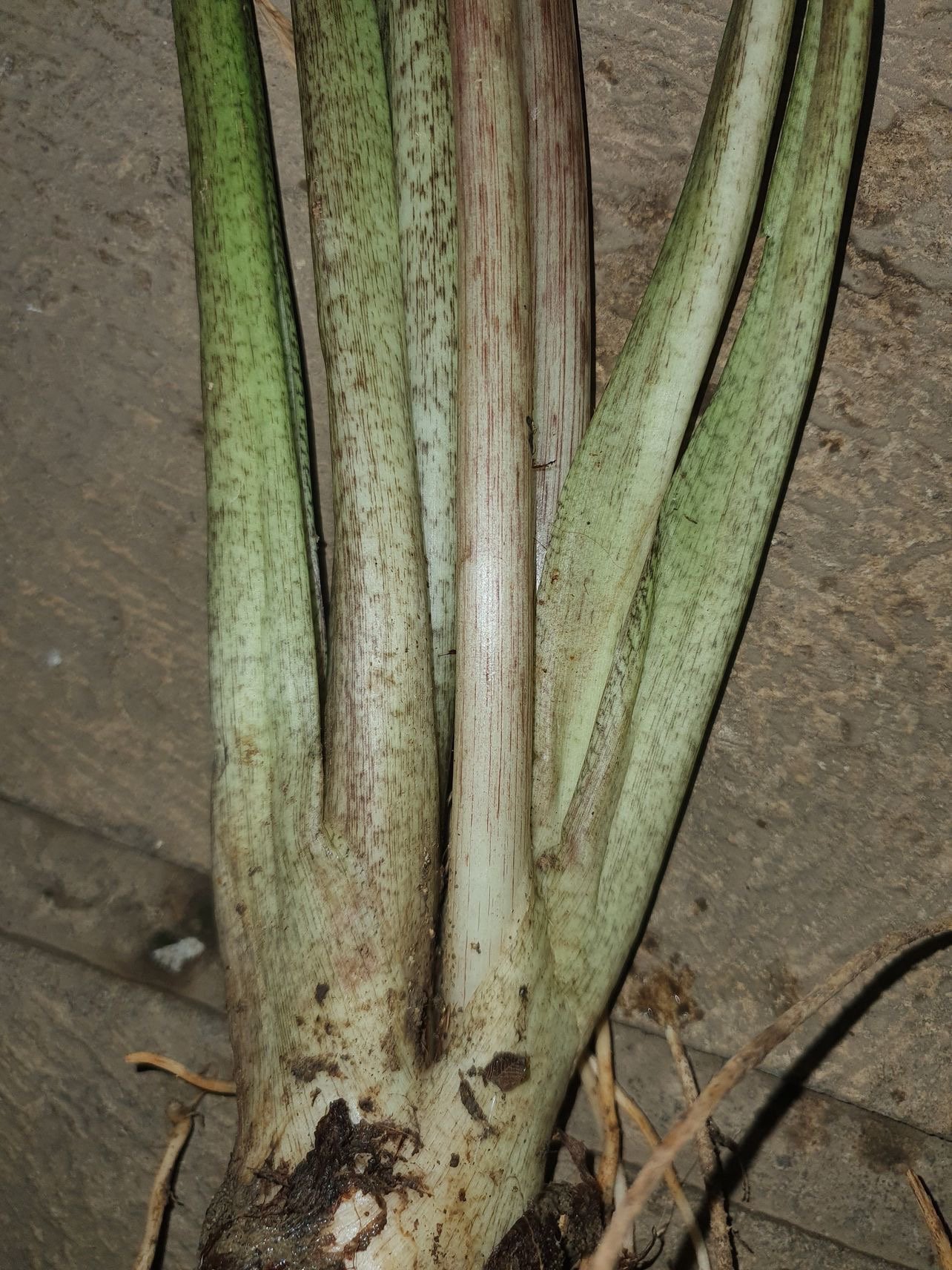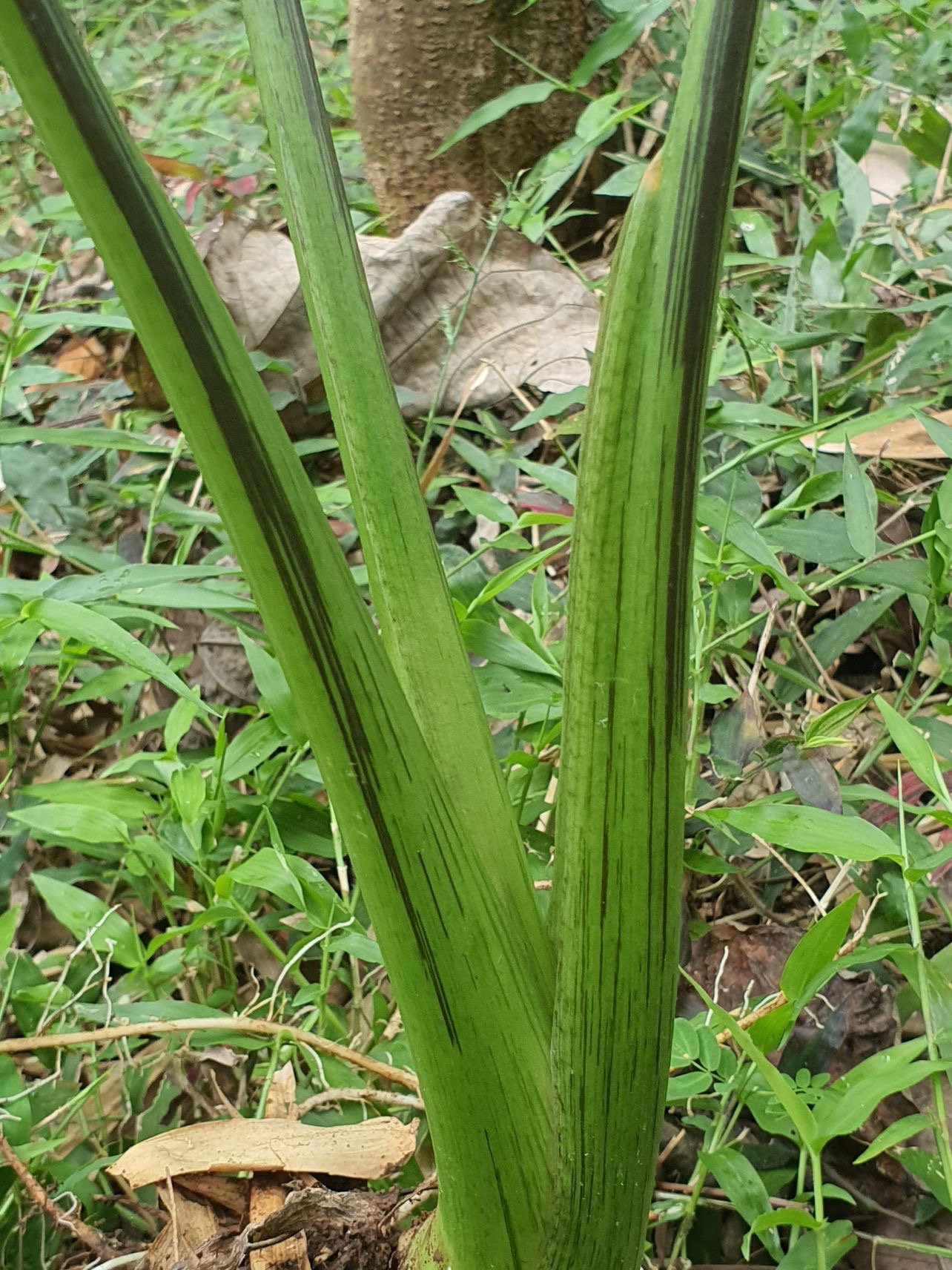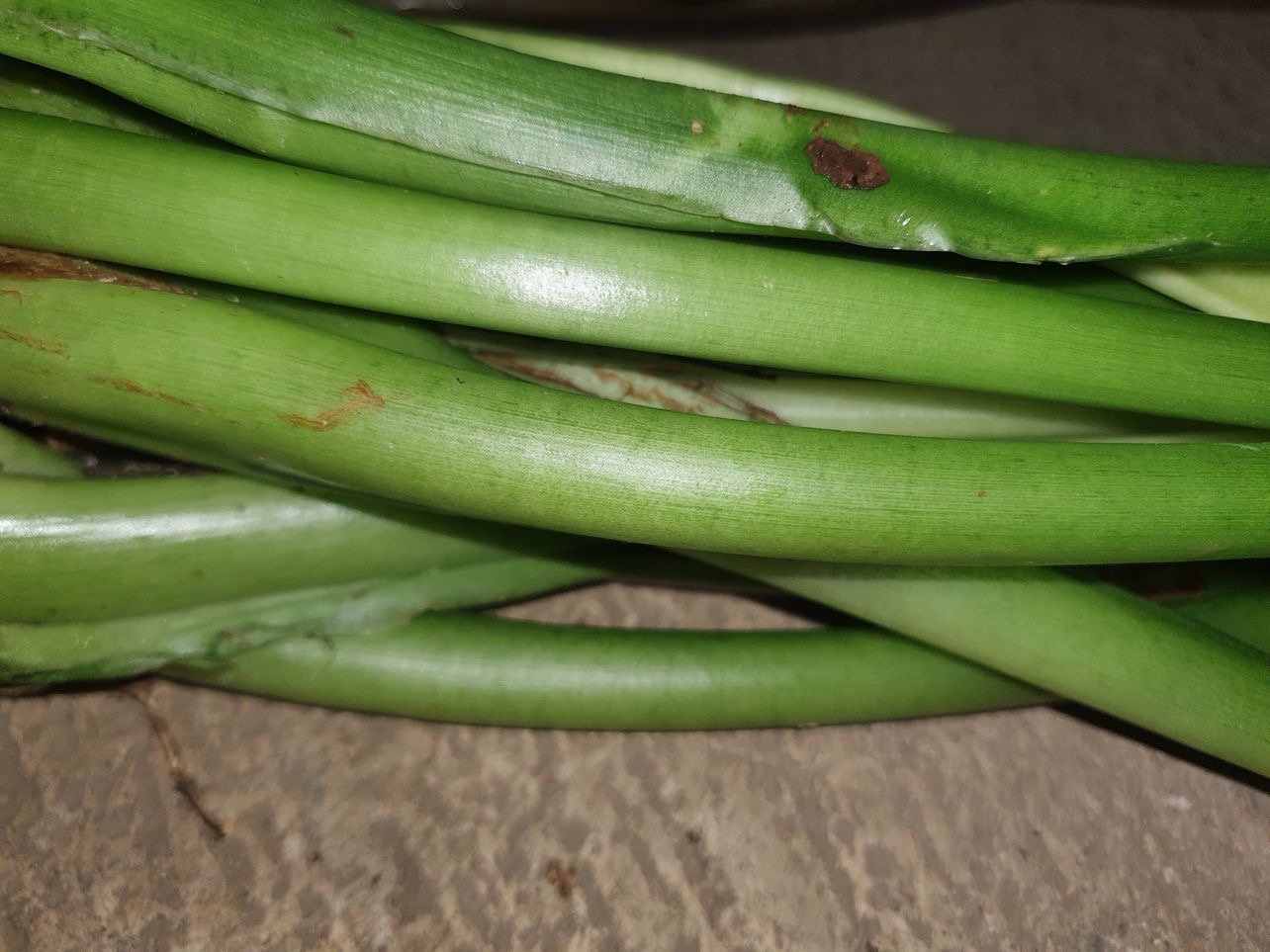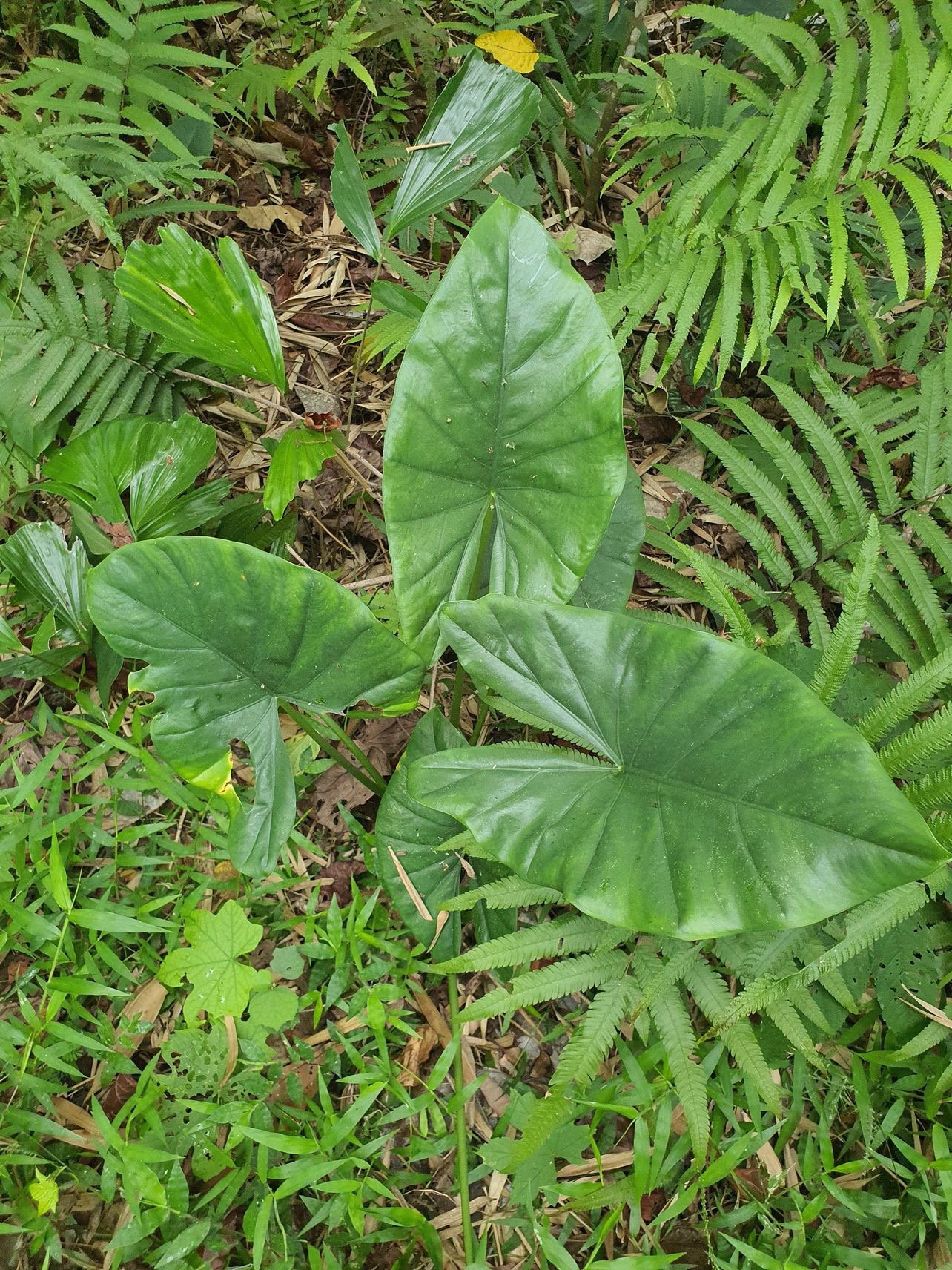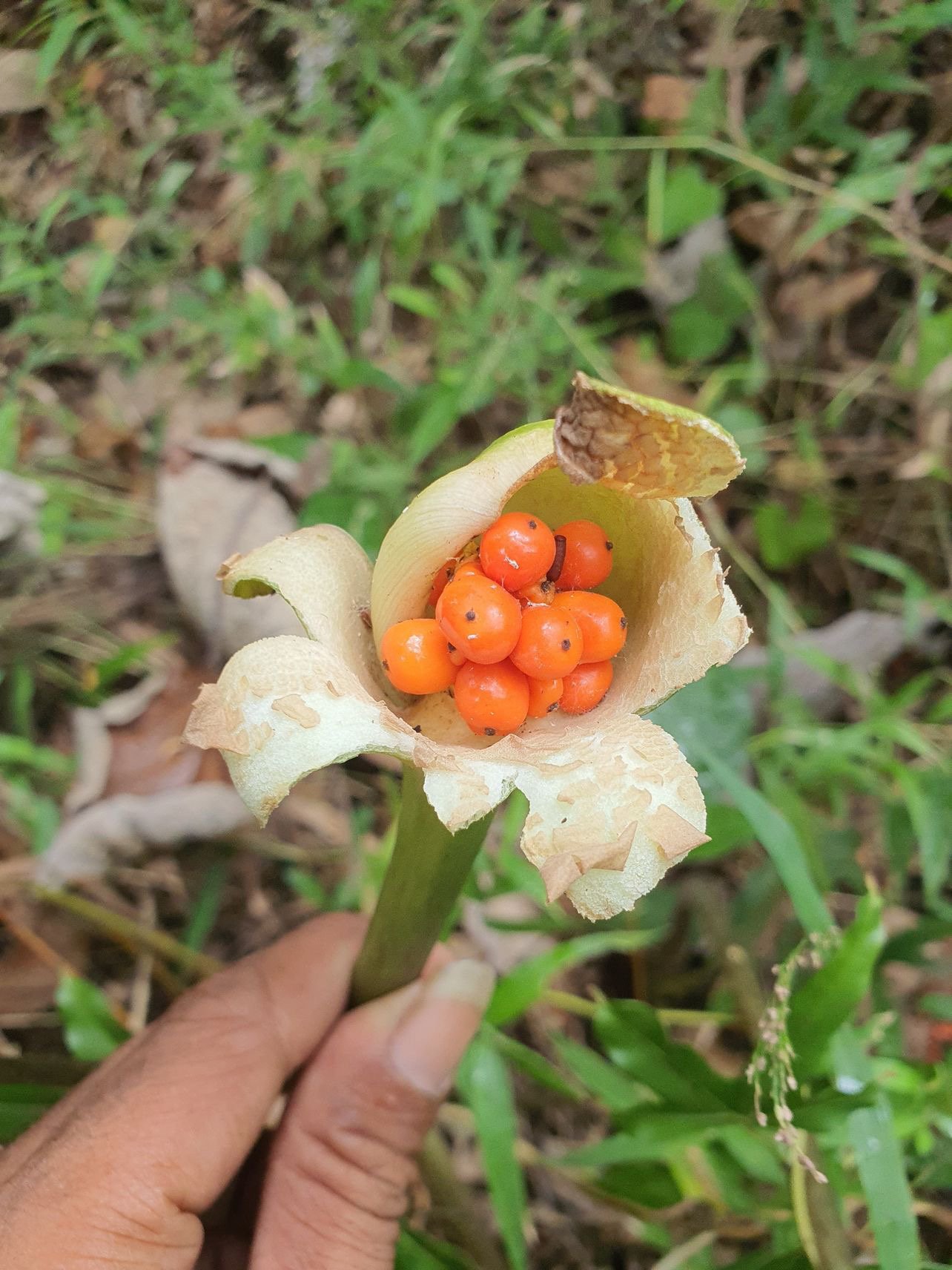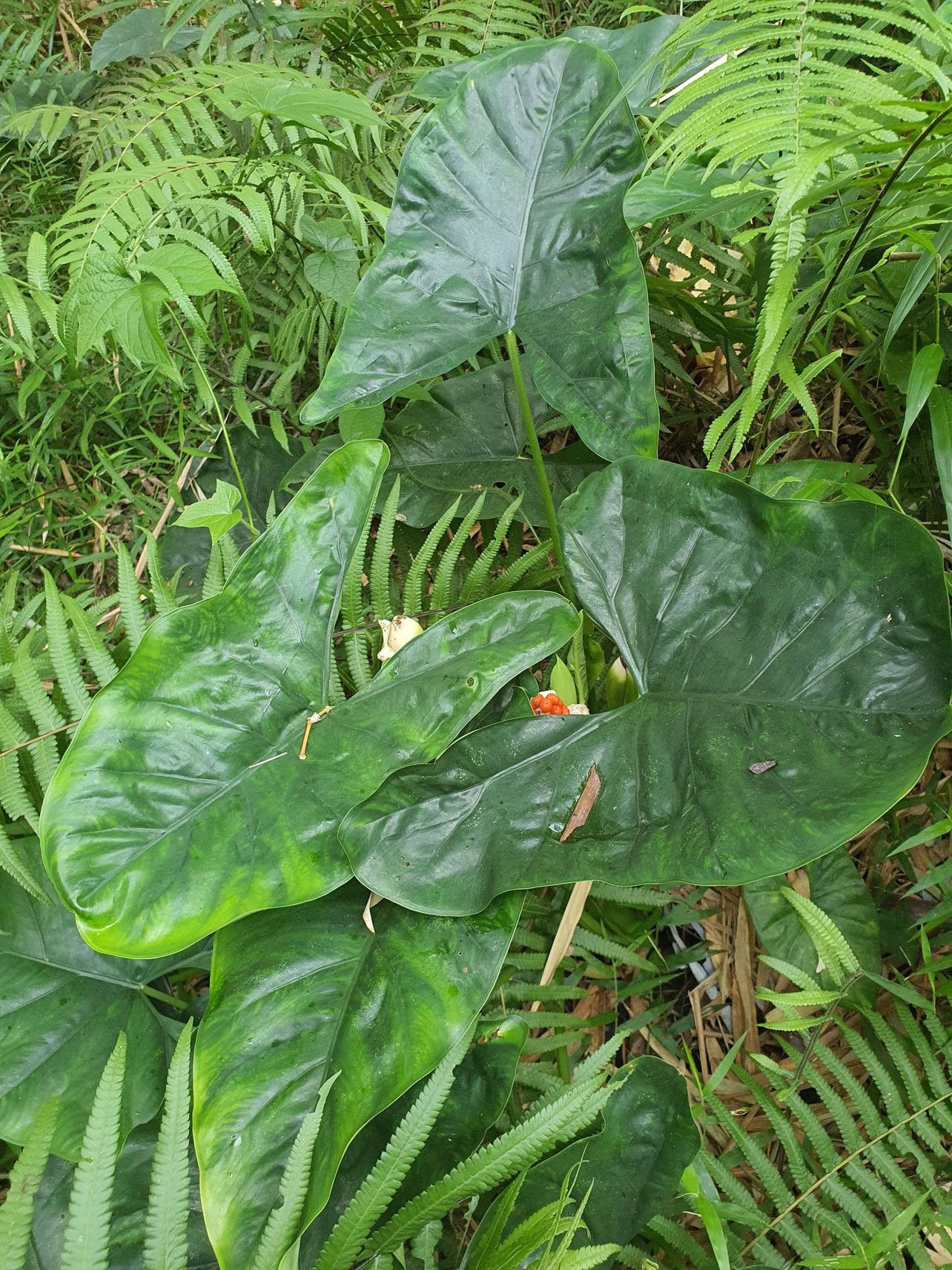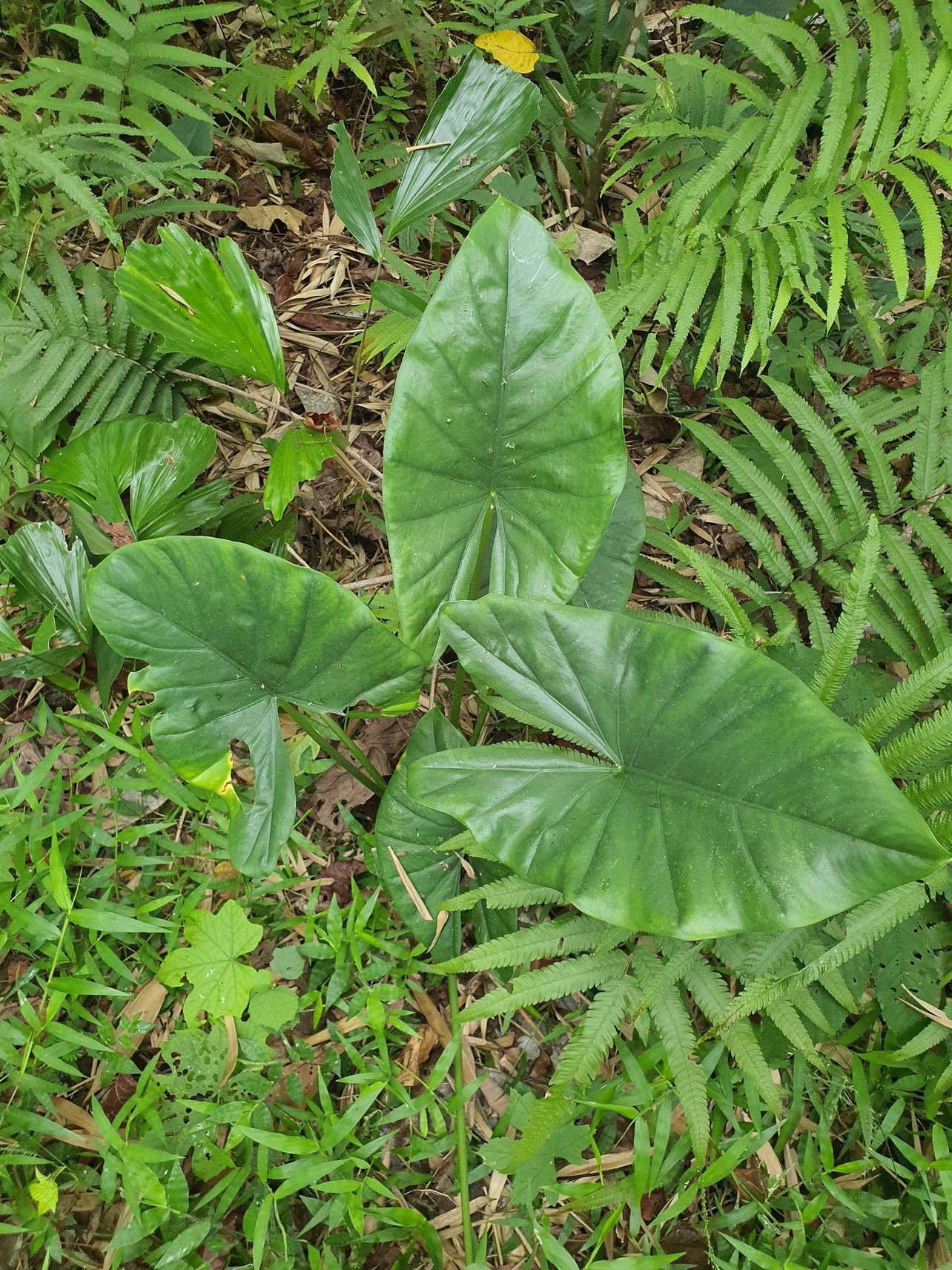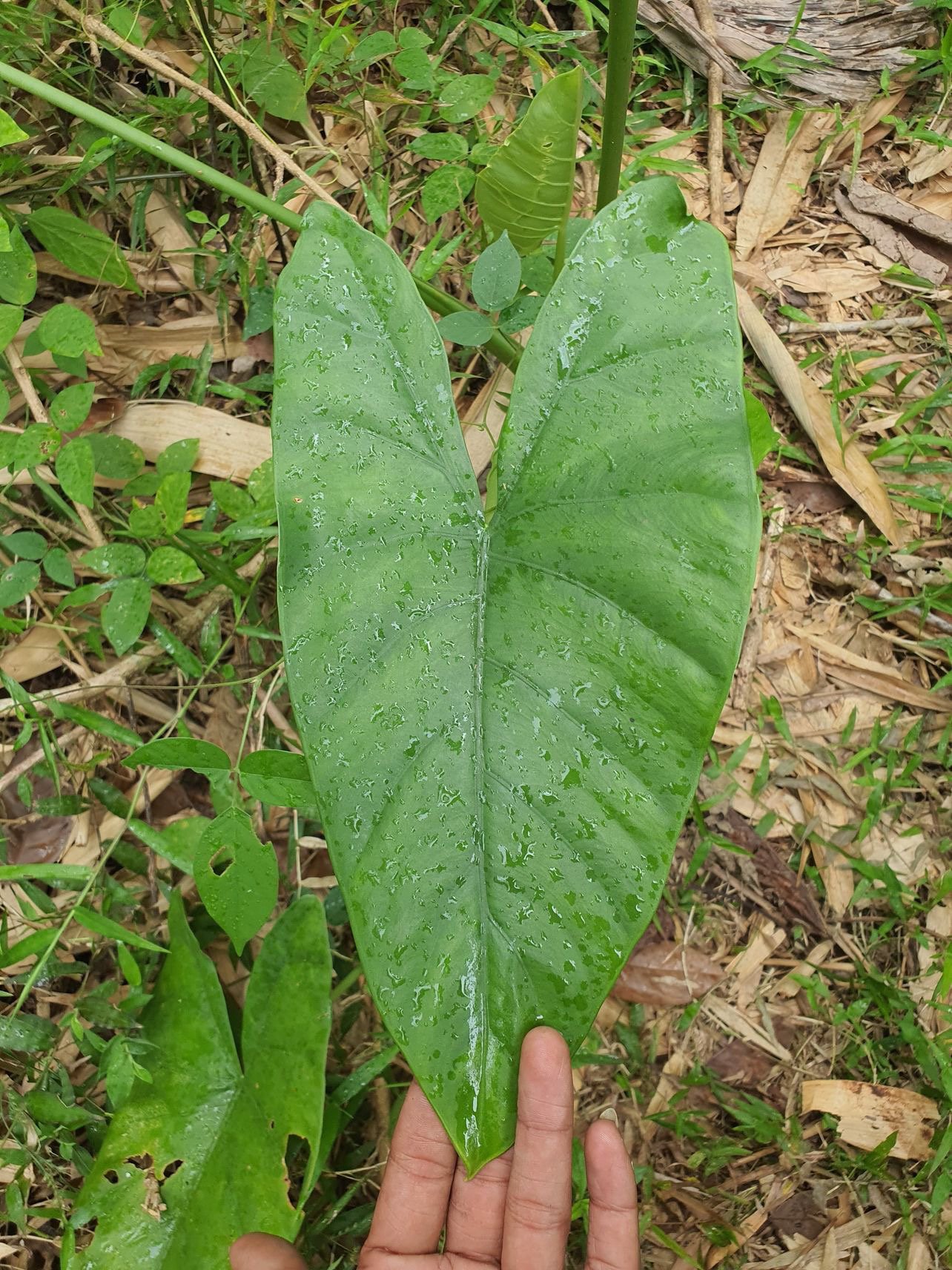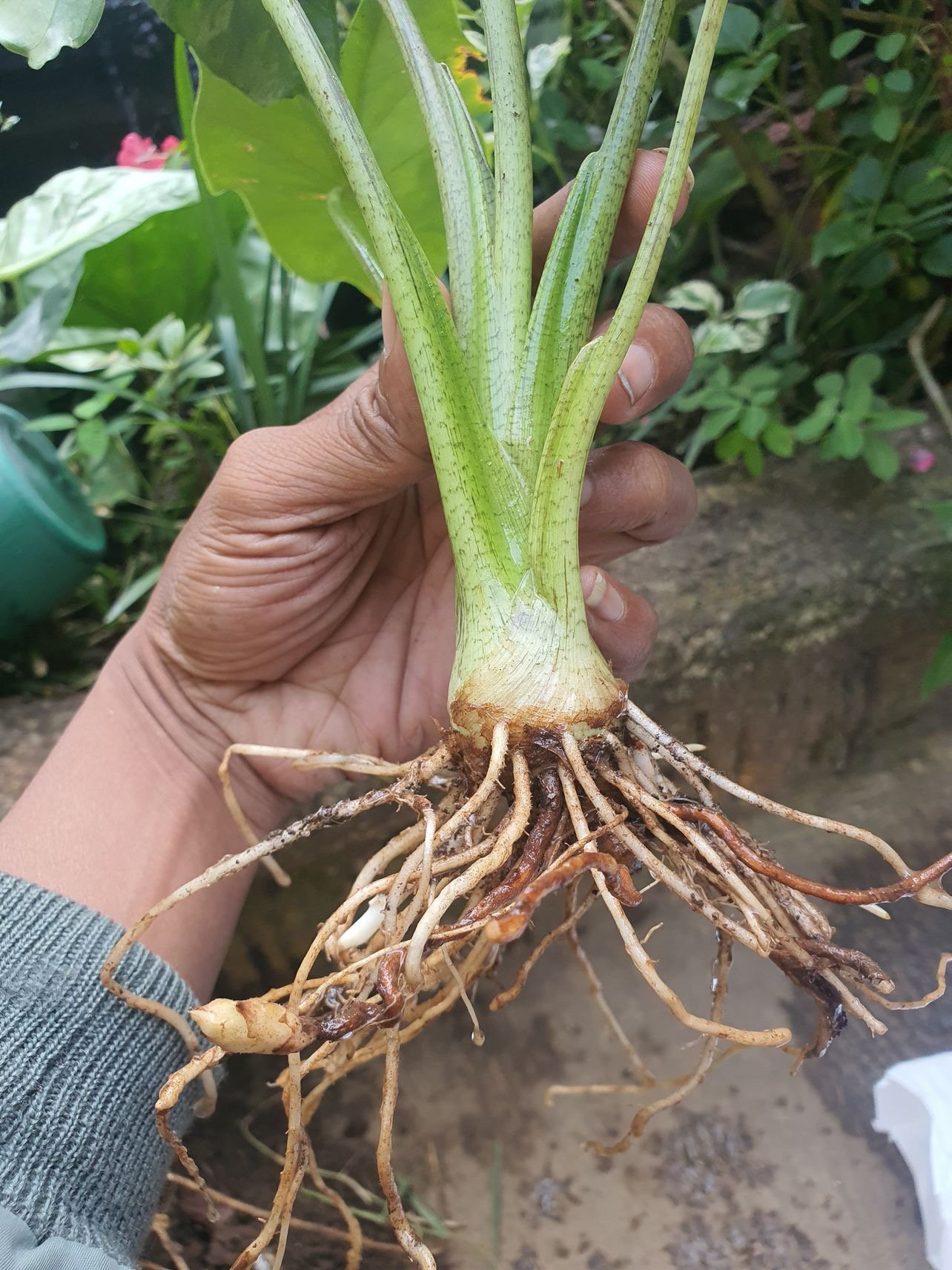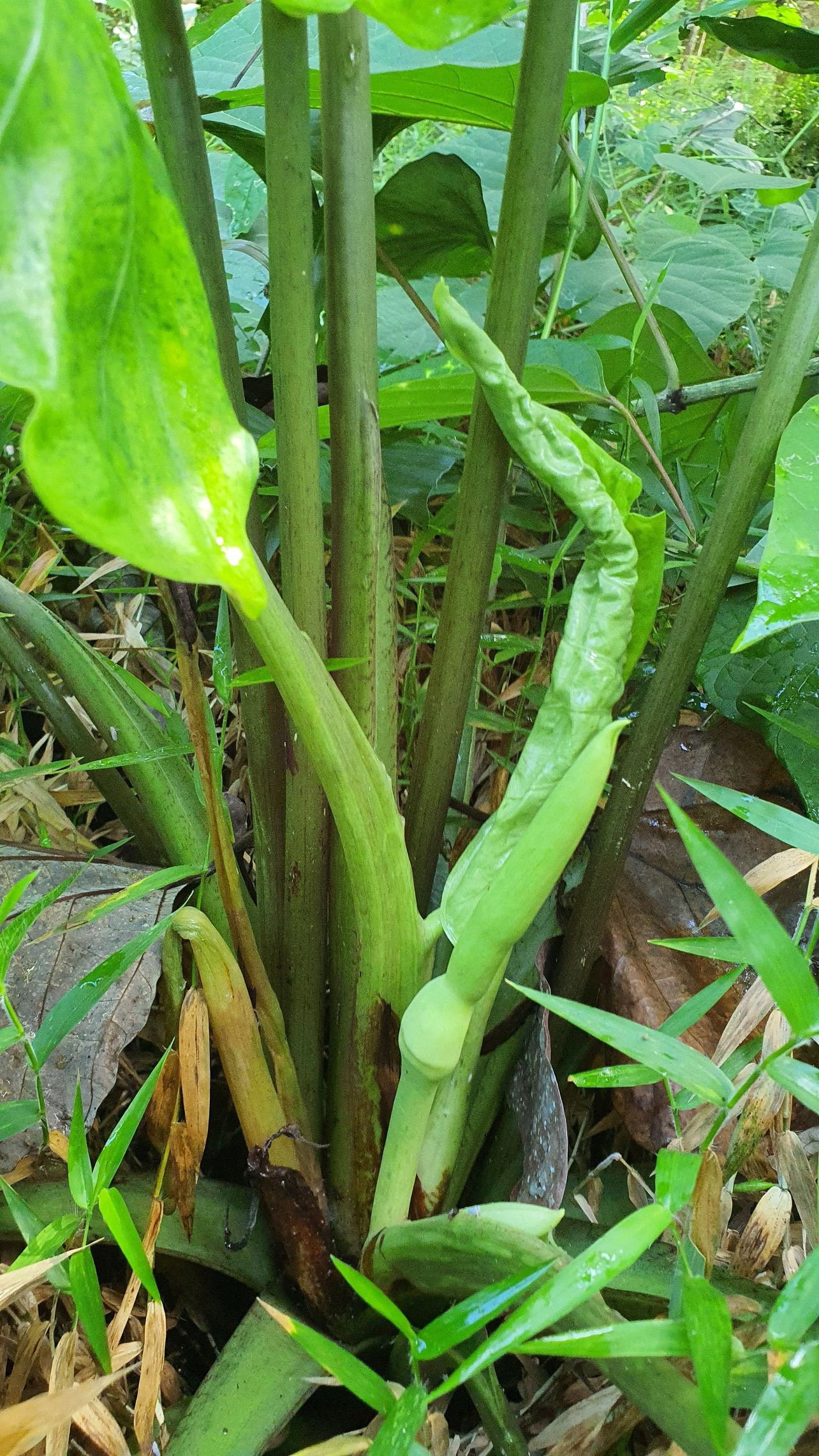ALOCASIA FLEMINGIANA
ORIGINAL DESCRIPTION:
Ah aliis speciebus javanicis statura minore, folii lamina adulta haud peltata nervo intramarginale praedita, interstitio neutro et spathae constrictio congruentibus, stigmate lobato sessih, synconnectivo expanso differt ae
TYPUS: Indonesia, West Java, Ciseeng, 25 km NNW of Bogor, 28 Jan 1961, Nicolson 848 (L, holo; BO, US, iso).
Photo by Alovasia
SYNONYMS: N/A
DISTRIBUTION: Indonesia | Java (widespread in West Java and sporadic in Central Java)
CLIMATE: Subtropical humid climate
Humidity is moderate throughout the year, ranging from 60% to 70%
Temperature is varies between the seasons - within the range of 48°F/9°C to 88°F/31°C during the day. Minimum temperatures never dip below 45°F/7°C
Rainy and humid season (October to May) and a dry season between June and October. The average annual rainfall is 1,200 mm
ECOLOGY: Found in teak-forest, swamp-forest, disturbed forest, on volcanic soils, sometimes over limestone, from sea level to ca. 1000 m altitude. Murata et al J-2042 (BO) recorded that this species was found on 'rocky sea coast'. This seems an unlikely habitat for Alocasia, and possibly there has been an error in labeling of this specimen.
SPECIES DESCRIPTION:
Small herb, ca. 50 cm tall; rhizome to ca. 3.5 cm diam.; leaves several together; petiole green, sometimes mottled reddish purple, sometimes purple-streaked, 25-55 cm long, sheathing in the lower about V4-1/3 of its length; blade mid-green adaxialy, green-yellowish abaxially, sagittate to broadly ovato-sagittate, thin, membranous, glabrous on both surfaces; anterior lobe ca. 25 cm long, ca. 19 cm wide, the tip acuminate, ca. 1 cm long, anterior costa with 3 or 4 primary veins on each side, diverging at ca. 40°-60°, prominent abaxially; primary veins often bearing small flat glands in the axils abaxially, running to a distinct submarginal vein ca. 1-3 mm from margin; secondary veins flush to lamina, interprimary collective veins absent or poorly differentiated; posterior lobes acute, up to ca. 16 cm long, inner sides elliptic to obovate; posterior costae diverging at ca. 90-110°, naked in the sinus for 0-1 cm;
The different presentationof petiole coloration in A. flemingiana: A. mottled reddish-purple, B. green and C. purple-streaked. Photos courtesy of AlocasiaPlanet
INFLORESCENCE:
Inflorescences in pairs interspersed with foliage leaves; peduncle, ca. 2/3 the length of the petiole at anthesis, elongating in fruit, up to ca. 31 cm long; spathe white to greenish white, ca. 10-15 cm long, lower spathe ovoid, ca. 2-4 cm long, constricted level with top of sterile zone of spadix (to half way along male zone); limb narrowly oblong and falling after anthesis; spadix somewhat shorter than to subequalling the spathe, ca. 8-11 cm long, slender, stipitate for ca. 0.5 cm; female zone to 1 cm long, with ca. 40 pistils; ovary globose, ca. 2 mm diam.; stigma sessile, ca. 1 mm diam., 2-3 lobed, the lobes bluntly pointed; sterile interstice hardly to somewhat attenuate, ca. 5 mm long, ca. 3 whorls of rounded to rhombo-hexagonal synandrodia; male zone 1.5 cm long, 5 mm wide; synandria rhombo-hexagonal to rhomboid, 1 mm diam., thecae somewhat displaced to overtopped by synconnective, opening through apical slits; appendix 6.5 cm long, tapering, cream; fruiting spathe becoming white, berries orange
VARIEGATED FORMS: WHITE
ETYMOLOGY: The specific epithet acknowledges Conrad D. Fleming's generous sponsorship of field work on Malesian Araceae, including Yuzammi's field work in Java during December 1997
NOTES:
Notes: 1. The rationale behind the application of Colocasia montana or Alocasia montana, both based on Arum montanum - which Roxburgh had coined for a plant from the Northern Circars in the Indian state of Orissa - to Javan material remains obscure, doubly so since the identity of Arum montanum is itself unclear. The earhest misapplication appears to have been that of Hasskarl (loc. cit.) who made the connection on the basis that his Javan plant and Arum montanum were both 'stemless', followed by Miquel and, much later, Koorders. Hooker (1894) also noted in his Flora of British India that Alocasia montana extended to Java. That opinion was not followed by Backer & Bakh. /. (1968) - though they in turn misapphed Alocasia heterophylla (Presl) Merr. to this species. Arum montanum Roxb. first appeared in Hortus Bengalensis (1814: 65) as a nomen nudum, and the first valid publication was in Roxburgh's Flora Indica 3 (1832: 497). There, he wrote:
“I long considered this to be A. [Arum] macrorrhizon, but changed my opinion on observing that Forster, who must have seen and examined that species in its recent state, says, the flowers are hermaphrodite; there being six sessile, twin anthers surrounding each germ, and that the stigma is orbicular. There are no traces of stamina, anthers or glands round the germs of my [Roxburgh's] plant; and the stigma is regularly three or four-lobed. In short, a very perfect Arum, or Caladium according to Ventenat.
Roxburgh did not record from where he took Forster's observation, but it was probably his dissertation on esculent plants (Forster, 1786), where he said of Arum macrorrhizon [I am indebted to Dan Nicolson for this]:
'Fructificatio a charactere generico aliquanto recedit, floculis in spadice omnibus et singulis hermaphoditis...COR. nulla./ STAM. Filamenta nulla. Antherae sex, spadice adnatae, didymae, singulo stylos cingunt./ PIST. Germen subrotundum. Stylus solitarius, brevis, crassiusculus, apice depressus. Stigma maculata orbiculata in apice styli....'
Arum macrorrhizon L. is the basionym of Alocasia macrorrhizos (L.) G. Don, and there is little doubt that either Forster's observation, or the way Roxburgh interpreted it, or the identification of the plant Forster observed, was incorrect. That being so, the probabihty is raised that Alocasia montana is identical with Alocasia macrorrhizos, as Roxburgh had originally thought. Neither Kunth, Schott, nor Engler and Krause, nor authors of floristic accounts of Alocasia in India have cited any additional specimens when treating Alocasia montana, simply reiterating descriptions obviously based on Roxburgh's protologue and the incomplete and rather naive illustration which, unless pertinent preserved material comes to light (Forman's (1997) account of Roxburghian species does not include Arum montanum), will form the type. In the absence of evidence to the contrary, it would seem reasonable to treat Alocasia montana (Roxb.) Schott as an Indian synonym of A. macrorrhizos (q.v.), at least provisionally; however, epitypification of Arum montanum will be dealt with elsewhere. Suffice to say that, even without unequivocally disposing of the name Alocasia montana (Roxb.) Schott, there appears no tangible basis for applying the name of a 'species' known from a bare description and a poor painting of a plant from Orissa and resembling Alocasia macrorrhizos, to plants of a species apparently endemic to Java and bearing little resemblance to Alocasia macrorrhizos, on the sole basis of 'stemless' habit - a characteristic of juveniles of most if not all species of Alocasia
2. Alocasia flemingiana was incorrectly identified as Alocasia heterophylla (Presl) Merrill by Backer & Bakh. (1968). However, these species are readily distinguished by the following features: Alocasia flemingiana has the lamina ovato-sagittate, with the margin entire, the leaf is only peltate in juvenile plants, and the sterile zone has relatively small synandrodia; Alocasia heterophylla has the lamina narrowly (hasto-) sagittate, sometimes deeply peltate in adult plants, with the margin sometimes undulate and the sterile zone with large synandrodia filling the upper part of the lower spathe chamber.
Other specimens seen:
JAVA: Hort. Bogor, Adelbert 400 (L); Banjumas, Tjilatjap, Backer 21009 (BO); Java, Batavia, Backer 34987 (BO); Java, Preanger, Tjadas Malang, Bakhuizen. 1379 (BO); Preanger, Tjadas Malang, Tjidadap, Tjibeber, Bakhuizen 1930 (BO); Madjalengka, Cirebon, Beumee 1753 (BO); Pekalongan, Margasari, Beumee 1767 (BO); Banjumas, Beumee 4845 (BO); Batavia, Krawang, Beumee 5397 (BO); Bidara Tjina, Edeling s.n. (BO); Tjiampea bij Buitenzorg, Koorders 30810b (BO); Pelabuhan Ratu, Koorders Alocasia in West Malesia and Sulawesi 297 34459h (BO), Koorders 34463b (BO), Nicolson 935 (BO, US), Nicolson 957 (BO); Cultuur Sepakaeng, Oengaran, Telomojo, Ambarawa, Semarang, Koorders 35968h (BO); Depok, Buitenzorg, Koorders 42817b (BO, L); Kranhau, West of Pelabuhan Ratu, W. Java, Murata, Kato, Mogea J-2042 (BO); Depok, W. Java, van Ooststroom 12609 (L); Tjilatjap, Riviere s.n. (L). Java, Preanger, Tjibodas, Sapiin 85 (BO); Tjirebon, Telaga Erang, Vermeiden 6 (BO); Miramere, Pamempek, West Java, Yuzammi 297042 (NSW); Miramere, Pamempek, West Java, Yuzammi 297043 (NSW).
CULTIVARS: N/A
HYBRIDS: N/A





